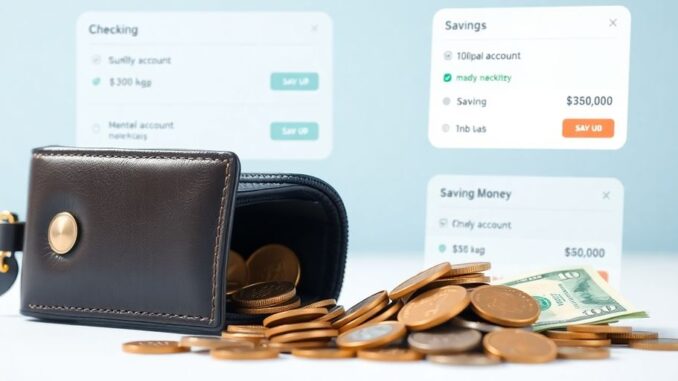
Understanding the nuances of different bank accounts is crucial for effective personal finance management. This guide explores the fundamental differences between checking and savings accounts, highlights the advantages of online versus traditional banking, and details the benefits of setting up mobile banking alerts to stay on top of your finances.
Checking vs. Savings Accounts: What’s the Difference?
Checking and savings accounts serve distinct purposes in managing your money. Checking accounts are primarily designed for everyday spending and bill payments, offering easy access to funds through debit cards, checks, and digital payment platforms. They typically do not earn interest and have no withdrawal limits. Savings accounts, on the other hand, are intended for setting aside money for future goals and emergencies. While they may offer interest to help your money grow, they often have limits on the number of withdrawals or transfers allowed per month. Banks may still impose these limits even though federal regulations have been suspended.
- Primary Use: Checking for daily spending, Savings for future goals.
- Interest: Checking accounts generally do not earn interest, while savings accounts may offer minimal interest.
- Access: Checking accounts offer easy access via debit cards and checks; savings accounts are typically accessed via ATMs or online transfers.
- Limits: Checking accounts have no withdrawal limits, while savings accounts may have monthly transaction limits.
Choosing Between Brick-and-Mortar and Online Banks
When selecting a financial institution, consider the trade-offs between traditional brick-and-mortar banks and online-only banks. Brick-and-mortar banks offer the convenience of in-person customer service and easy cash deposits, along with a wider range of financial products. However, they often come with higher fees and lower interest rates on savings. Online banks, conversely, typically provide higher Annual Percentage Yields (APYs) on savings products and charge fewer fees due to lower overhead costs. While they may lack physical branches, many offer robust digital tools and ATM fee reimbursements.
- Brick-and-Mortar Pros: In-person service, easy cash deposits, wide product variety.
- Brick-and-Mortar Cons: Higher fees, lower savings rates.
- Online Bank Pros: Higher savings rates, fewer fees, advanced digital tools.
- Online Bank Cons: Limited cash accessibility, fewer customer service options, fewer account types.
Savings Accounts with No Minimum Deposit
Many banks now offer savings accounts that do not require an initial minimum deposit, making it easier for everyone to start saving. These accounts often come with no monthly maintenance fees and competitive APYs. When choosing a savings account, look for FDIC insurance, consider the APY, and evaluate how easily you can access your funds. Some banks even offer unique features like earning rewards or allowing you to set up savings goals within the account.
Types of Checking Accounts
Checking accounts come in various forms, each with unique features to suit different needs. These include traditional checking accounts for everyday use, interest-bearing accounts for those who maintain higher balances, and premium accounts offering additional perks. Student and teen checking accounts are tailored for younger individuals, often with lower fees and parental controls. Other types include joint accounts for shared finances, senior accounts with specific benefits, business accounts for commercial use, checkless accounts for digital-only transactions, rewards accounts for earning points or cash back, private banking accounts for high-net-worth individuals, and second-chance accounts for those rebuilding their banking history.
Leveraging Mobile Banking Alerts
Mobile banking alerts are a powerful tool for managing your finances and protecting yourself from fraud. Setting up alerts for low balances can help you avoid overdraft fees. Direct deposit alerts confirm when your paycheck has arrived. Unusual account activity and large purchase or withdrawal alerts can immediately notify you of potential fraud. Debit card alerts help track spending, while profile change alerts warn of unauthorized changes to your account information. Upcoming payment alerts can remind you of scheduled or recurring bills. It’s important to be aware of potential alert scams and to only trust alerts from official bank communications.
- Low Balance Alerts: Prevent overdraft fees.
- Unusual Activity Alerts: Detect potential fraud.
- Direct Deposit Alerts: Confirm incoming funds.
- Large Transaction Alerts: Monitor significant spending or withdrawals.
- Profile Change Alerts: Safeguard against unauthorized account modifications.
- Upcoming Payment Alerts: Track scheduled payments and subscriptions.
Sources
- Savings vs. Checking Accounts: What’s the Difference?, Kiplinger.
- Brick-And-Mortar Banks Vs. Online Banks: Pros And Cons, Bankrate.
- These savings accounts have no minimum deposit, Bankrate.
- 13 Types Of Checking Accounts, Bankrate.
- 8 Important Mobile Banking Alerts to Set Up Today, Bankrate.

